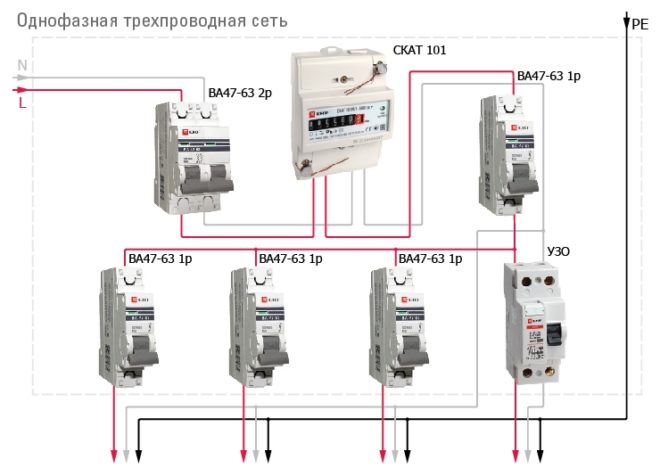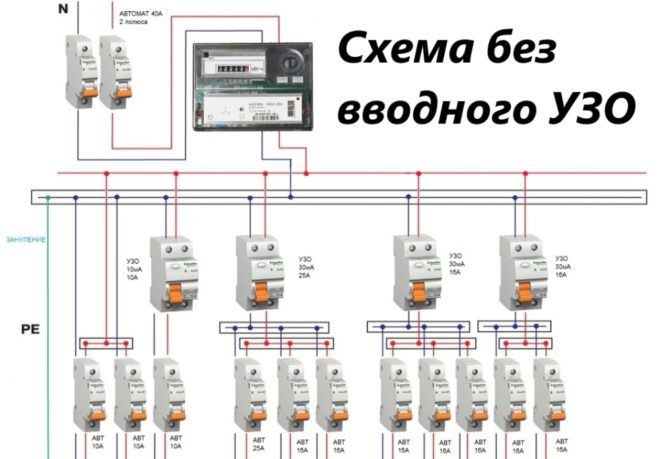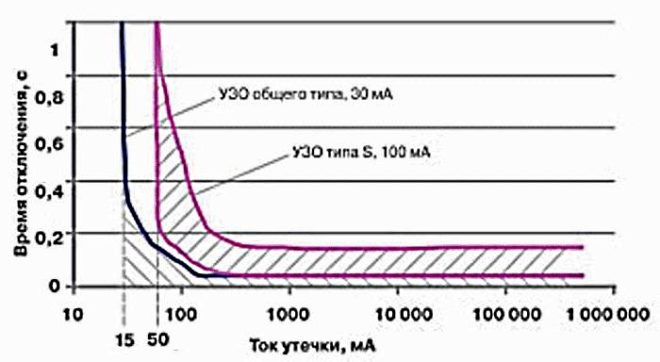RCD connection diagrams in single-phase and three-phase networks

Today, many are already familiar with the concept of an RCD. The installation of these devices is necessary if we take care of ourselves and our loved ones, and want to have a safe electrical network in our homes. Many people ignore these RCDs - some do not want to remodel the switchboard, for others it is too expensive. And it is completely in vain, because the RCD connection diagram is not complicated. As for the financial costs, there are options for circuits when only one device is mounted at the input. You can fork out for this, especially when it comes to the safety of human life.
Content
Getting to know your device
Before connecting an RCD, it would be nice to understand its design, operating principle and basic functions.
What is it for?
The main task of the RCD is to protect people from electric shock. A person can accidentally touch exposed wires that are energized. Or touch the body of a household appliance, which has a potential due to damage to the insulation. In any of these cases, the device will trip and power supply will stop.
It also protects our home from fires, which can be caused by current leaks or ground faults. The fact is that in these cases, the current is not enough to turn off the circuit breaker, designed to work with overload and short circuit overcurrents.
Similarities and differences between RCDs and machines
The appearance, design and basic parameters of the residual current device are very similar to the circuit breakers. Both of these switching devices are used in both single-phase and three-phase networks. The main task of both RCDs and machines is to instantly cut off the damaged section of the electrical network in emergency situations.
The only difference is that the machine operates with large currents (with overloads and short circuits, they exceed the operating current of the circuit breaker itself). And for the RCD to trip, a small leakage current is enough.
So that large currents at the time of the accident do not have a negative effect on the residual current device, it must be connected to the circuit together with the machine.
If you look at the appearance of the RCD and the machine, you will not find any special differences, it seems that they are one and the same device.
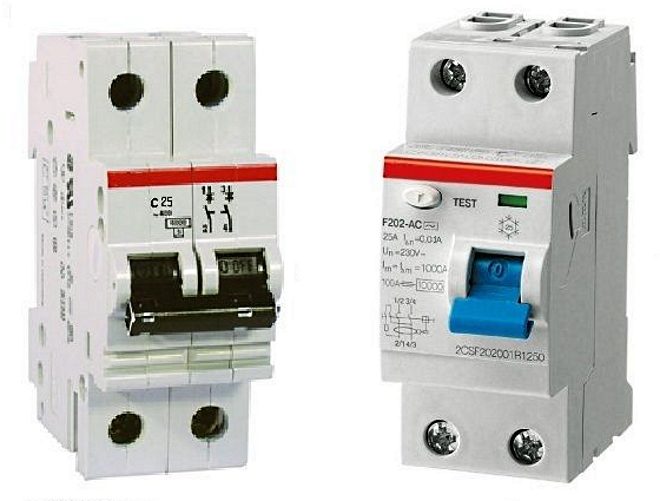
But one has only to take a closer look at the diagrams and numbers drawn on the case, as it becomes immediately clear - where is which apparatus.
- They will have the same rated operating voltage - 220 V or 380 V.
- The operating current can also be the same, which is classified on a special scale (10, 16, 25, 32 A). The working current is the maximum current at which the device operates normally.
- The fundamental difference will be such a parameter as the magnitude of the leakage current. You will not find it on the machine, but on the RCD this figure is written and indicated in milliamperes. It also has its own standard range - 6, 10, 30, 100 mA.
- An important difference between the RCD and the machine is the "TEST" button. These devices are designed with an additional test circuit that simulates the leakage current. With the help of such a circuit, the serviceable state of the RCD is checked, the test is started with the "TEST" button.
The most important difference between machines and RCDs is that the circuit breaker will also work in a two-wire single-phase network, that is, a phase and zero are enough for it. And in order for the RCD to work correctly, there must be a three-wire single-phase network, in addition to the phase and zero, there must be a protective ground.
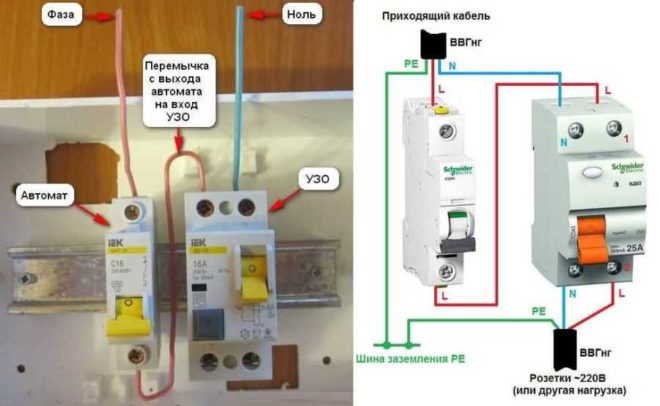
Scheme options
This is not to say that there is one specific scheme. Each case has its own characteristics, so the connection of the RCD can be done in different ways. Firstly, the device is used in single-phase and three-phase voltage networks (these are two different circuits). Secondly, you can install an RCD at the input and thus protect the entire apartment from current leaks. And you can install devices for each separate line, thereby protecting only a certain section of the electrical network.
An example of connecting an RCD in a single-phase network in the video:
Since the circuit for connecting an RCD has several options, it is very important that you can read them. Now in the passports of many electrical appliances and equipment it is indicated how and through what type of RCD it is necessary to connect them to the electrical network.
These recommendations cannot be ignored. Manufacturers of washing machines or microwave ovens write them not on a whim, but for your safety.
Let's look at how to properly connect an RCD using a few general examples.
What is a single-phase network?
With a single-phase electrical network, consumers are powered by two conductors - a phase and a working zero. The rated voltage in such networks is 220 V.
A single-phase network can be of two-wire and three-wire design. In the first case, two conductors are used - phase and zero, in the diagrams they are designated by the English letters "L" and "N".
The second option, in addition to phase and zero, also provides for the presence of a protective grounding conductor (its designation "PE"). The main function of this ground wire is to additionally protect people from electric shock. Due to its connection to the enclosures of electrical appliances, in the event of a phase short to the body, the power supply will be cut off. This will save both human life and the equipment itself from burnout.
And now let's talk about what the RCD connection diagram can be in a single-phase network.
Input connection (single-phase)
In this case, the installation of the RCD is carried out in the panel after the introductory two-pole machine. Outgoing circuit breakers are located after the residual current device. Such a circuit for switching on the RCD provides simultaneous protection against current leaks for all outgoing consumers.
The disadvantage of the scheme is the difficulty of finding the place of damage. For example, there was a phase closure on the metal case of some household appliance that is currently plugged into an outlet.
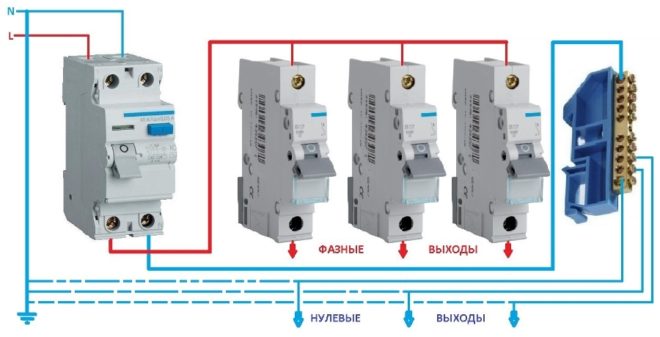
The RCD is triggered, the voltage disappears in the apartment. If at this time several devices were plugged into the sockets, then it will be problematic to immediately determine the damaged one.
This scheme also has positive aspects. Due to the fact that only one residual current device is used, the installation of the switchboard is cheap, and it itself will be small in size.
Keep in mind that another type of such a scheme has become widespread; in it, it is customary to install an electric energy meter between the input machine and the RCD.
Connection at the entrance and outgoing lines (in a single-phase network)
With this version of the circuit, the RCD is installed after the input circuit breaker and also on each outgoing line.
The most important condition for this circuit is the observance of selectivity, that is, at the moment of the appearance of a current leakage, there should not be a simultaneous disconnection of the general and group RCD.
Let's talk about what selectivity is just below.
For example, there was a current leak on one of the outgoing lines. A device that protects this particular group should work.
If, for some reason, the RCD did not work, then after a certain time (this is called a time delay) the common RCD at the input will turn off, it seems to insure the outgoing one.
The undoubted plus of this scheme is that at the time of damage only the emergency line will be turned off, and the voltage supply will not stop in the rest of the apartment.
The disadvantages of such a scheme are in the large dimensions of the switchboard and in the high cost (RCD is not a cheap thing, and with this option you will need several of them).
In the video, a comparison of several connection schemes:
You can save a little and omit a single-phase RCD at the input in this circuit, that is, install only group devices on outgoing lines. Many electricians generally consider an introductory RCD a waste of money, because each line already has its own protection. But as we said above, it is a kind of safety net in case the group device fails. Therefore, it all depends on your financial capabilities. There is money - install a circuit with an RCD at the entrance. If so expensive, install only the outgoing devices, that will be great too. Many people do not install an RCD at all, preferring to save money on their own safety.
Installation of the device in a single-phase network
There is nothing difficult here. The phase and neutral conductor ("L" and "N") following the input machine must be connected to the input contacts of the RCD.
From the output contact, the phase conductor ("L") is distributed to the circuit breakers of outgoing consumers. Zero conductor ("N") from the RCD output is connected to the zero bus. And already from it, working zeros diverge to consumers.
Don't forget about the protective conductor! A grounding bar must be installed. From it, protective conductors ("PE") diverge according to consumer groups.
The connection algorithm is as follows:
- De-energize the workplace by turning off the input machine for the apartment. Check the absence of voltage on its output contacts with an indicator screwdriver.
- Mount the device on the DIN rail. It has special perforated holes into which the rear RCD latches are inserted.
- Now you need to correctly connect the RCD and the machine. Decide on the diagram, whether you will have a residual current device on a separate line or after the meter. The upper and lower contacts for the phase and neutral wires are marked on the RCD case, perform the appropriate switching actions. According to the diagram, the input is connected to the RCD from above, and the load is already connected from below.
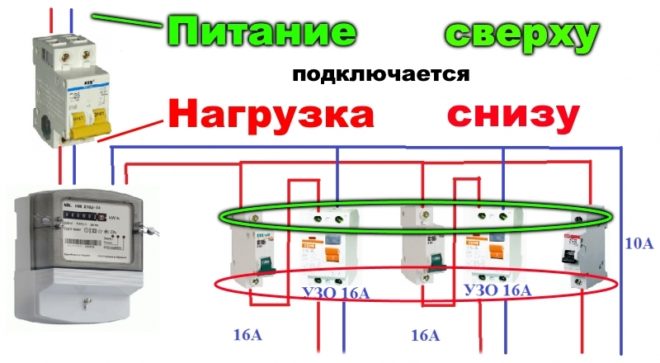
- After completing all the commutations, it is necessary to apply voltage and check the operation of the RCD by pressing the "TEST" button. A simulation of the leakage current will occur, the device should react and shut down.
What is a three-phase network and how to connect an RCD in it?
In a three-phase network there is also a phase and zero, only three phase conductors ("L 1", "L 2", "L 3"). The voltage between any of the phases is 380 V, between phase and zero - 220 V. It is very important in such an electrical network to perform an even distribution of the load between the phases. If one phase is loaded more and the other is less, there will be an imbalance, and as a result, an emergency.
Similar to a single-phase network, a three-phase network can consist of four or five conductors. In the first case, there are three phase wires and a zero, in the second, a protective grounding conductor is added.
An example of assembling a three-phase electrical panel in the video:
Installation of an RCD in a three-phase network is carried out in the same way as in a single-phase network: you can install it only at the input or connect one more residual current device for each outgoing consumer group. The option is also appropriate when an electricity meter is connected between the input circuit breaker and the RCD.
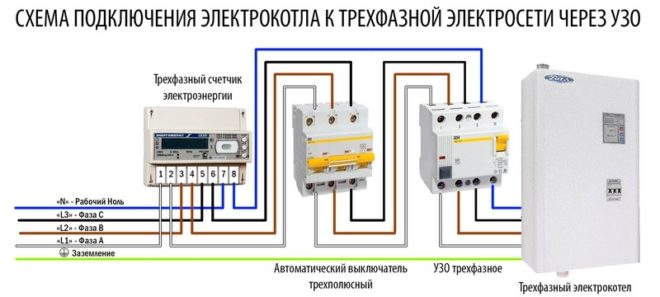
In apartments, you are unlikely to meet a three-phase network anywhere, but for private houses a voltage of 380 V may be required to connect pumps, motors, machines.
Selectivity
RCDs with a selectivity function differ from ordinary ones in that they have a certain time delay. They are used when several devices are mounted in one switchboard at once. In order for the whole chain to work smoothly, it is imperative to adjust the settings for the response time. According to this characteristic, RCDs are of two types: "G" and "S".
Clearly about the selectivity of the RCD in the video:
An ordinary RCD trips in 0.02-0.03 s after detecting a current leakage, a device of type "G" after 0.06-0.08 s. RCD type "S" has the longest time delay of 0.15-0.5 s.
The residual current device on the outgoing lines is mounted without time delay, the input is of the type "S" or "G". As soon as a leakage current appears on some consumer line, the group RCD instantly reacts and turns off.
If it is not working properly or for some other reason did not work, then after a specified time the input device will turn off.
Selectivity can be ensured not only in time but also in current.
A few tips for choosing
And some recommendations for choosing an RCD. If you plan to install one device at the input, then choose quality products from well-established manufacturers. These are firms such as:
- "ABB";
- "Legrand";
- Schneider Electric.
Residual current devices from these manufacturers will cost you about 1800-2000 rubles.
If you want to connect several RCDs and machines in the apartment (for each outgoing branch), then you will have to either spend well or choose devices a little cheaper. In case of small financial opportunities, opt for RCDs of IEK or EKF firms, they are slightly inferior in terms of quality and reliability, but they also cost much less (about 600-700 rubles).
We have given several options for how to connect an RCD. Choose the most suitable one for yourself, depending on where you live (in an apartment or a private house), what kind of network you have (single-phase or three-phase). Well, how many devices you supply (one at the input or for each consumer group), decide based on your financial situation.


